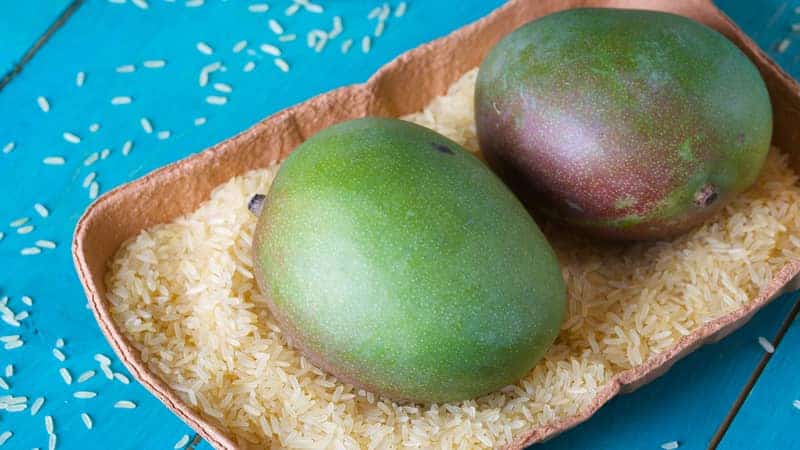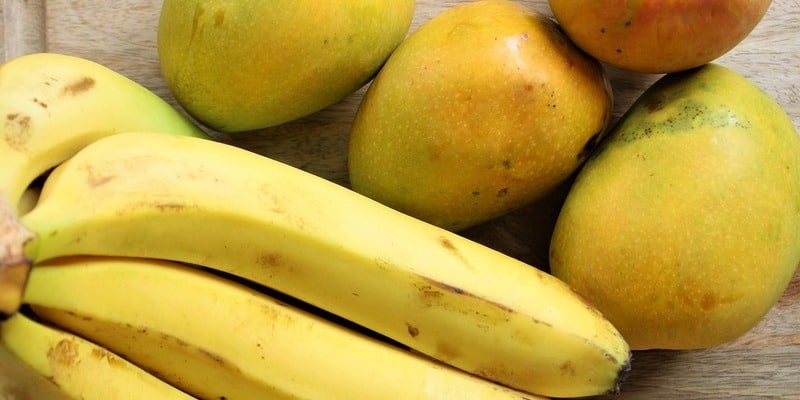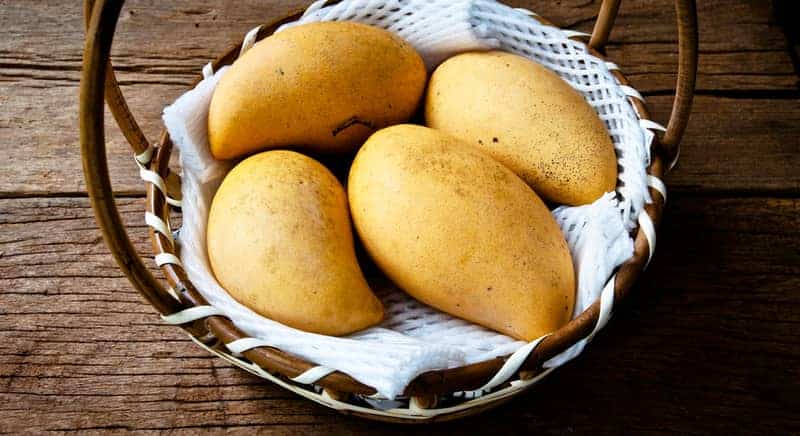Nothing beats a cold, delicious mango on a summer day. When these tropical fruits are in season, it feels like heaven.
But before you start looking up mango recipes or laying out those mango slices, you need to check – are your fruits ripe to eat?
Mangoes take between 4–5 days to ripen at room temperature. But if you want fresh mango for your fruit salad ASAP, there are some tricks you can use to ripen a mango:
- Wrapped in a paper bag or newspaper
- Uncooked rice or popcorn kernels
- Other fruits
- Sunlight
- Microwave method
Speeding up the mango ripening process lets you dig into these delicious fruits faster. So grab your bag of unripe mangoes, pick your method, and man-go go go!
How to Tell a Mango is Ripe
If you want to tell if a mango is ripe, check two things: feel and smell.
Unripe mangoes have a green colour and will be very firm when held. They will smell either sharp and tangy, or like nothing.
Meanwhile, ripe mangoes will have reddish pinkish, or yellowish colours. If you do a gentle squeeze, the skin should “give” a little – but shouldn’t feel mushy.
Additionally, ripe mangoes will smell sweet and fruity.
You can actually eat some varieties of mango while they’re green, though!
Don’t panic if you see black spots on ripe mango skin, though! They may just be imperfections, and not necessarily an indicator of over-ripeness or damage.
Do Mangoes Ripen Off the Tree?

Yes, they do! Mango fruits will continue to ripen even after they’re picked. The whole process takes up to 5 days.
If you’ve grown a mango tree in your yard, you can pick mangoes even before they’re ripe. Then store them or ripen them indoors.
For store-bought mangoes, they’re often harvested before ripening so they survive transport, storage, and sale.
How to Ripen Mangoes at Home Naturally
Patience is a virtue, but the thought of a ripe mango likes to test us. The natural ripening process takes 4–5 days, but sometimes we can’t wait that long.
Here are some of the best ways to ripen mangoes at home.
1. Using a brown paper bag
One popular method for ripening mangoes is to use a paper bag. If you’re wondering how to ripen mangoes overnight, this is the best way to do it naturally.
This method works due to ethylene, an odourless gas that ripens fruits. By wrapping mangoes, you trap the ethylene, so the fruit will ripen naturally – just faster.
Wrap the unripe mangoes in a paper bag (or newspaper). Leave them out at room temperature for around 1–2 days.
Make sure to leave a gap for air to escape, though. Fully enclosing the mangoes will also trap moisture, which can lead to mould or rot.
TIP: If you have a small cardboard box, that’ll work as well!
2. Using uncooked rice or popcorn kernels

No, this doesn’t work the same way that rice fixes your phone! It’s just another method for trapping ethylene.
Bury your mangoes in uncooked rice (such as in the rice container) or uncooked popcorn.
Remember, though: this will work much faster than the paper bag method! Check on your fruit in 6 hours. If the mangoes aren’t ripe yet, leave them for another few hours.
Generally, you should have fruit ready to eat in half a day.
3. Using other fruits

How to ripen green mangoes? Buddy them up with other fruits.
Other ripening or ripe fruits also release ethylene, so grouping these together with mangoes will speed up the ripening process.
You can put all the fruits together in a bowl, or wrap the mangoes in a paper bag with your chosen fruit. Some suggestions include bananas or apples.
Check on the fruit after 1–2 days to make sure it’s not over-ripe.
NOTE: Do not use already-ripe bananas or apples. Chances are these fruits will spoil before your mangoes have finished ripening, and could trigger spoilage instead.
4. Using sunlight

Warmth does speed up ripening, so sunlight will help ripen a mango quickly. Simply place your fruits in a sunny spot for a few hours.
Be careful with this method, though! Too much heat can make a mango spoil or attract fruit flies.
How to Ripen Mangoes Quickly Using the Microwave
This will give the most immediate results, but the fruit won’t taste as good. Microwaving a mango tends to make it less sweet.
For this method, poke the mango a few times with a knife or toothpick. Don’t skip this step – no one wants to clean exploded mangoes out of their microwave.
Wrap the mango in a clean cloth or towel, then place it in the microwave.
Run the microwave on high power for 10 seconds, then check the mango. If it’s reached the desired softness, take it out. If not, flip it over and microwave for another 10 seconds.
Storing Ripe Mangoes

When storing ripe mangoes, it’s important to know that mangoes have a short shelf life, especially if kept at room temperature.
If you leave a ripe mango out at room temperature, it’ll last about 2–3 days.
Meanwhile, placing mangoes in a refrigerator will let them last up to 7 days. The cold temperature will slow down the ripening process.
Unpeeled mangoes can go in your produce bin, but peeled or sliced mangoes must be placed in an airtight container.
You can also freeze this versatile fruit to keep it longer! Place cut-up mango chunks on a baking sheet and put them in the freezer for 3–5 hours. Transfer the fruit to a freezer-safe container afterwards.
Note that freezing mango will change its consistency when defrosted. This method is best for creating chunks to make mango shakes and other blended foods.
To store green mangoes, wrap them in a plastic bag or place them in a cardboard box to prevent fruit flies (or curious snouts or hands) from getting to them.

